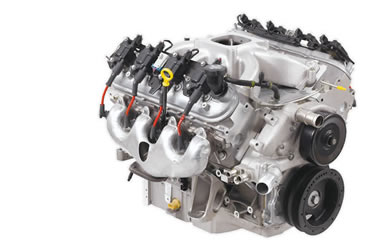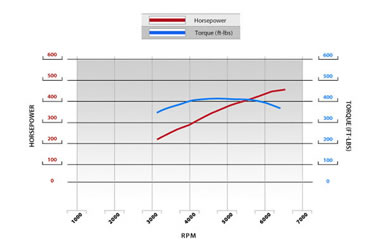Is there such thing as too much technology?
For many old school hot rodders, the answer is a resounding “yes.” Take engine technology, for example. Today’s innovative engines deliver unsurpassed efficiency and power output. However, that power comes complete with the extra wiring, sensors, and high-pressure fuel line that make up the modern electronic fuel injection system. And those extra wires and sensors bring something else–headaches to many old school rodders.
Fortunately, GM Performance Parts came to the rescue with its carbureted LS 364 crate engine. GM engineers took the powerful LS2 engine and swapped out the EFI manifold with a GM LS1 4-barrel intake manifold. That means die-hard carburetion guys can now bring new-age GM technology to their street rods or 1960s-era musclecars.
High-Tech Foundation
The LS 364 is built on a direct replacement aluminum LS2 block. Based on the successful 5.7L LS1, the LS2 features 6.0L of displacement (hint: that’s 364 cubic inches). The LS 364 short block features iron sleeves, a structural oiling system, and six-bolt mains. Ideal for stroker applications, it comes with an impressive array of internals designed to handle up to 450 horsepower, including:
* 3.62-inch stroke, nodular iron crankshaft
* Powdered steel connecting rods
* Cast aluminum flat top pistons, 10.9:1 compression
* Hydraulic roller camshaft with 200-degree intake/203-degree exhaust
duration, .500-inch intake/.500-inch exhaust lift
Proven Cylinder Head Design
The LS364 features aluminum cylinder heads, similar to the ones used on Corvette LS6 engines. The heads sport GM’s cutting-edge “cathedral port” intake ports, which were introduced on the LS heads back in 1997. The distinctly tall, narrow design of these ports allows them to fit between the four head bolt and pushrod holes. The result is evenly spaced, symmetrically configured intake ports, which allow a freer flow of incoming air. In addition, the taller cathedral ports have proven to increase the velocity of the incoming air/fuel mixture for more efficient combustion.
To maximize the amount of air that flows into the LS 364, Chevrolet Performance Parts engineers CNC-ported the intake runners on the heads to 250cc-a 40cc increase over the standard LS6 heads. They also ported the D-shaped exhaust ports to 85cc for a 15cc increase over the standard ports. The heads have a 61cc combustion chamber and come with 1.7:1-ratio, cast aluminum roller rockers and 2.00-inch intake/1.55-inch exhaust valves for maximum performance.
The high-flowing heads and valvetrain components, in combination with the .500-inch lift cam, allow the LS 364 crate motor to make over 440 horsepower and 410 foot-pounds of torque straight out of the crate.
Old School Carburetion
For all of its new age features, what makes the LS 364 unique–and appealing to hot rod purists–is its intake manifold. While the LS engines have traditionally featured electronic fuel injection, GM Performance gave the LS 364 engine a four-barrel intake manifold to work with a square bore, Holley 4150/4160-style carburetor.
The cast aluminum intake has a single plane open plenum design to deliver crisp throttle response with excellent high-rpm power-up to 440 horsepower, according to GM. The manifold is specially designed by GM to work with its cathedral port cylinder heads.
The LS 364’s carbureted setup allows you to put a high-tech small block Chevy performance to your classic 1960s musclecar or add an old school carbureted combination to your 1990s F-body.
The choice is yours thanks to GM Performance Parts’ LS 364 crate engine.





Comments